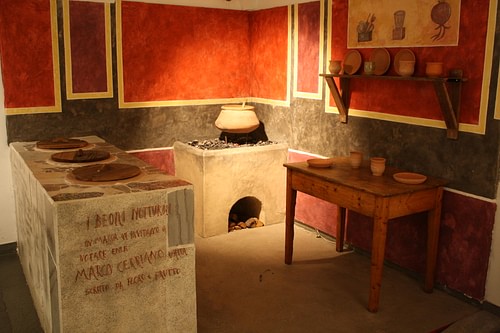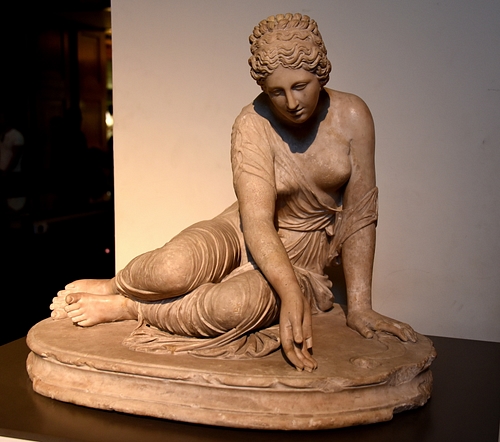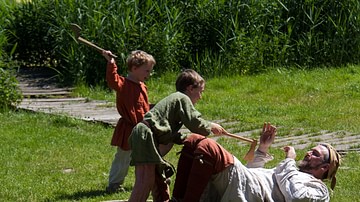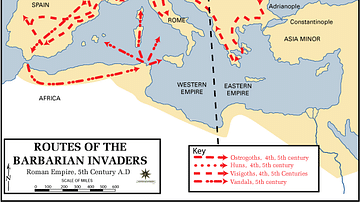Freeborn Roman children, ingenuiae, born of Roman citizen parents lived a life that was dictated by the level of society into which they were born; a day in the life of a child from the lower level of society and one from the more affluent, were worlds apart.
Living Spaces
In ancient Rome, as in many large cities, where building space was limited, living quarters needed to rise to several levels to accommodate as many people as possible. These closely packed apartment blocks, known as insulae, many of which had shops on the ground floor, housed the wealthier tenants on the lower upper floors of the apartment block. On the higher levels, where the living spaces became smaller, lived the less well-off families. The apartments were cramped, sometimes dark and cold, lacked running water, were not connected to a sewer system and cooking facilities may have had to be shared. The satirist, Juvenal (c. 55-138 CE) remarks that in the city, sleep only comes to the wealthy (Sat. 3.236); it was the wealthy who could afford the privacy and comfort of the larger apartments or a free-standing home, domus, on the edge of the city.
All Romans started their day at sunrise or the first hour. The Roman child and his family living in the city would have woken to the noise of the swelling crowds. In Satire III, Juvenal describes the congested city where the rich man might be carried in a litter above the heads of the crowd, and the wagons piled high with timber and marble swayed dangerously from side to side as they made their way through the throngs of people. The poet Martial (c. 38 to 103 CE) also complains about the constant noise in the city.
As children and families prepared for the day ahead, they may have begun it with breakfast, lentaculum. It is suggested that Romans did not necessarily take breakfast, however, if they did, the poorer child was likely to have boiled wheat or bread. All classes of society purchased food from street vendors and food shops, but the lower-income families relied on it more often.

The Working Child
The life of working-class families could be harsh; wages were low and sometimes their jobs were only temporary. For these families, the expectation was that their children would begin work from a young age; childhood was brief, and many children worked as the extra income would have been crucial to the family. Very few poorer children could access education, though there were some who were fortunate in that their parents were able to send them to school for a short time, enough to allow them to learn skills sufficient to equip them for employment. In Petronius' Satyricon (written in the 1st CE), one of his guests describes the education he had as practical and useful, however, most poorer children remained illiterate.
Young children were employed in various areas of work. Children worked on the streets where they might hawk products such as fruit and flowers. Boys sometimes followed their fathers into their father's trade; a father who was a mirror maker with Legio XIV at Carnuntum, records on his child's funerary stone, that his ten-year-old son died so young, while he was still in training as a mirror maker. The parent also commemorates the death of his five-year-old daughter who had also started helping her parents (ILS 9094). Families who worked outside the city on farms had their children working with them, children could be given age-appropriate tasks, beginning with gathering fruit, weeding, and bird-keeping.
Some parents had their children become apprentices in a trade, which offered the prospect of better financial rewards than general labour. Apprenticeship contracts had a start age of 12 years, and the service may have lasted anything from six months to six years. Boys training in the trades and crafts may have trained as weavers, stonemasons, coppersmiths, etc. According to his funerary stone, the young boy, C. Vettius Capitolinus was an embroiderer when he died aged 13 (CIL. VI.6182). There is evidence that girls, too, trained in particular areas such as goldsmithing and hairdressing; nine-year-old Viccentia had been a gold-spinner before her premature death (CIL. VI.9213), but it is generally accepted that girls mostly worked in the domestic field or in retail.
Children could also be found working in gruelling and dangerous jobs such as mining, where due to their size, they were indispensable for certain tasks. Some shafts and galleries in excavated Roman mines were so low and narrow that only children, equipped with smaller tools could have worked there; children would make their way down shafts to collect rock and bring it to the surface. In the Museo Arqueologico Nacional, Madrid, the funerary stone of Quartulus, provides an image of a possible child miner. Quartulus is barefooted and is depicted wearing a short, loose tunic, holding a pickaxe and a basket (CIL. II. 3258).

Research on children's accidents suggests that some of these accidents may have been work-related, for instance, a young boy was struck whilst giving feed to cows and a three-year-old was buried by stakes whilst helping his parents. The skeletal remains of children found in ancient cemeteries sometimes show signs of hard physical labour; remains of children recovered from a cemetery near an ancient laundry and textile works outside Rome showed signs of years of the heavy work involved in the treatment of cloth.
Education
The child from the more affluent family may have lived in a large apartment in the city, or the wealthier few in large houses which may have accommodated not only the child's immediate family but also relatives and the family slaves. The expectation for these children was that they would be trained and educated for positions in upper-class society; formal education usually began at seven.
Some parents employed a tutor or the child was sent to school. Boys would receive a formal Roman education; one which Pliny the Younger (61-112 CE) refers to as combining strict training, good manners, and moral standards (Ep. 3.3.3). Roman girls may have received some formal education, too, however, they were being educated to assume the role of upper-class matrons and were expected to marry and become mothers at quite an early age. Children who were educated outside of the home would be accompanied to and from school by their paedagogue whose job it was to take care of their charges and keep them safe whenever they left the house. A slave may also have accompanied them to carry the child's schoolbooks and equipment. Children may only have spent the morning hours in school, returning home at lunchtime (older students would have attended afternoon school). On his return home, the schoolchild may have had a meal of bread, cheese, olives, figs, and nuts prepared for him.
Leisure Activities
We could imagine children returning from school may have spent time with a family pet. Although Pliny the Younger mentions a child who had many pets (Ep. 4.2) and Libanius, orator and teacher (314-393 CE), recalls rearing doves as a hobby when he was a child (Or. 1. 4-5), it has been suggested that a child with a pet was, in fact, a privileged one.
The afternoons may also have been an opportunity for a boy and his father to spend time together, and this was the most popular time to attend the baths. The Roman baths were available to everyone. Most towns had more than one bath complex; the state baths, thermae, were usually larger than the private, balneae, and would have provided more recreational facilities. It was not uncommon for the bath complexes to have areas for ball games, exercising, and swimming. Afterwards, the shops at the baths provided drinks and pastries.
All children play no matter what their place in society, and it is here we find the similarities in the children's lives. The working children would have had to take their playtime whenever they could, with the streets being where they played. The children from the more affluent families would have enjoyed more free time. These children might have enjoyed playing soldiers or their favourite charioteer, with some being able to afford to wear the colours of their favourite team (Juv. Sat. 5.143-4). Games and toys popular with all children included the knuckles and bones game, similar to today's game of Jackstones. Knucklebones were often sheep or pig's knuckles or could be made from more costly substances such as ivory, stone, glass, or marble.
Dolls made of clay, wood, or ivory were a part of playtime, so were balls, which may have been made with skins stuffed with feathers or air. Spinning tops and hoops with small rings attached to make a jingling noise which children could roll through the streets were also popular.
The End of the Day
The main meal of the day, cena, was in the evening. The foods available to the child of a poorer family included boiled wheat, bread, beans, leeks, and sheep's lips. For the well-off, there was a greater selection including, fruits, cheeses, eggs, vegetables, fish and meats. As the day came to an end, Roman children and their families prepared to retire; basins and jugs of water were used to wash, the chamber pots were set out, flames around the living spaces which were used for heat and light were extinguished and the doors and shutters closed tight.










